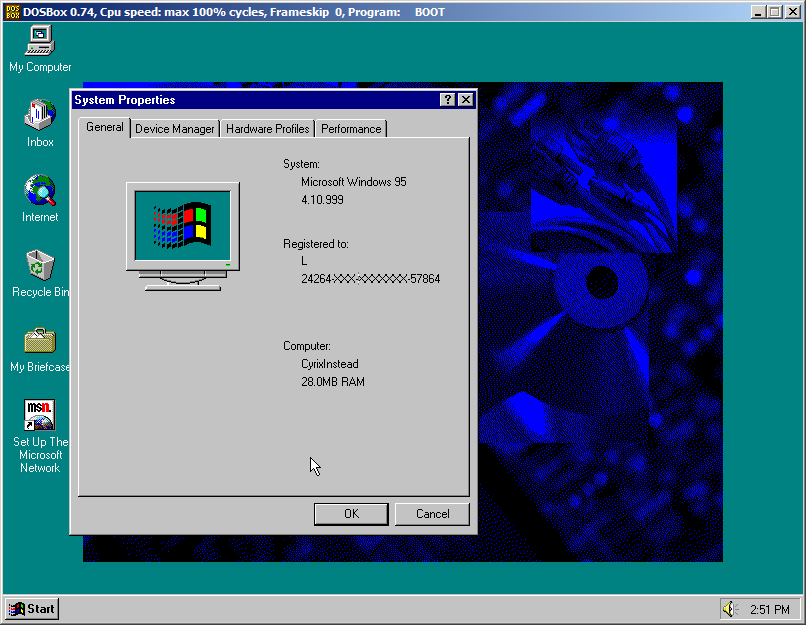
- RUNNING DOSBOX WINDOWS 95 256 COLORS INSTALL
- RUNNING DOSBOX WINDOWS 95 256 COLORS DRIVERS
- RUNNING DOSBOX WINDOWS 95 256 COLORS DRIVER
- RUNNING DOSBOX WINDOWS 95 256 COLORS UPGRADE
Windows 95's desktop would instead be a visual display of a directory and most frequently used for shortcuts to frequently used programs. This function would be turned into the Taskbar of Windows 95. The desktop in Windows 3.1 only displays active, minimized programs. The Program Manager of Windows 3.1, which encompasses all programs, would be turned into the Start button of Windows 95. You may use a drop down menu to manipulate icons. Unlike the universal drop down menu of the Macintosh, each Window may have its own menu bar. A window or icons in a window may also be closed through a drop down menu. The - button allows you move or resize the window with the cursor keys, close the window or enter the task switcher. When Maximized, the button changes to an Up and Down button, which then Restores the window to its previous, non maximized size. The Down and Up arrow buttons on the top right of each window correspond to Minimize and Maximize buttons. The User Interface for Windows 3.1 should be quite familiar to users of more recent versions of Windows. A mistake may require you to reinstall Windows 3.1, but that is easy to do.
RUNNING DOSBOX WINDOWS 95 256 COLORS DRIVER
However, Windows 3.1 installations can be rather brittle, it does not respond well to hardware upgrades or failed device driver installations. The Windows registry does exist but is not used. Uninstalling programs can often be done simply by deleting their icons and their directories. Once you know your way around the OS, it is really quite easy to manipulate. It can also boot far more quickly than Windows 95. Unlike Windows 95, you can shut down by pressing the power button and not have to worry about scandisk running on restart.
RUNNING DOSBOX WINDOWS 95 256 COLORS INSTALL
You must install a version of DOS before installing Windows 3.1, but the DOS you install does not have to come from Microsoft.Ĭompared to Windows 95, 3.1 is rather streamlined.

MSCDEX.EXE must be loaded for Windows to recognize a CD-ROM drive.
RUNNING DOSBOX WINDOWS 95 256 COLORS DRIVERS
DOS is required to run underneath it and often peripherals like CD-ROMs or certain sound cards (Pro Audio Spectrums) require loading DOS drivers in order for programs to work with them.
RUNNING DOSBOX WINDOWS 95 256 COLORS UPGRADE
Windows 3.1 functions as a GUI upgrade for DOS.

While many games were still designed for DOS, many CD-ROM programs began to tout their friendliness toward Windows 3.1 as well with executables designed for Windows as well as DOS. Windows 3.1 was a system hog when it came to resources and many DOS games did not work with it or performed very poorly on it. Windows 3.1 did advertise that it could it could multitask with DOS programs, but the results were rather mixed. Some games even had "Boss Keys" which were intended to fool your supervisor if you happened to be playing a game at work. In order to start another program, you had to quit your game. DOS games relied on unfettered access to hardware, especially RAM, the video adapter and the system timers. Multitasking and DOS gaming were grudging companions at best. For the first time users could easily access more than one program on a PC through the task switcher because the operating system was built for multitasking. Most control was accomplished using a mouse. Unlike the text command line parser of DOS, Windows was a graphical operating system with nary a command prompt in sight.

Windows 3.1 main draw was its support for multimedia, essentially sound cards, MIDI devices and CD-ROM audio. (Windows 3.00a with Multimedia Extensions was available from OEMs). This was the first version of Windows that Microsoft really designed for gaming applications and was available to purchase at retail.

Microsoft Windows released Windows 3.1 on April 6, 1992.


 0 kommentar(er)
0 kommentar(er)
